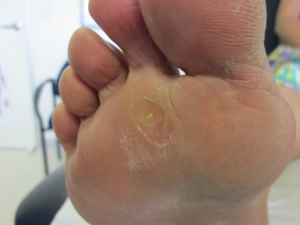Frequently Asked Questions
How to identify a foot corn?
Identifying a foot corn involves recognizing a small, hardened area of skin, typically on the toes or the ball of the foot, that may have a distinct core in the center.
What is the main cause of a callus on the foot?
The main cause of a callus on the foot is excessive friction or pressure on the skin, often from ill-fitting shoes, improper foot mechanics, or weight-bearing on bony prominences.
Can foot calluses be a sign of a larger issue?
Foot calluses can indeed be a sign of a larger underlying issue, such as diabetes, arthritis, or poor circulation. Proper evaluation by a podiatrist is recommended to identify and address any underlying medical conditions contributing to callus formation.
Can a callus be a sign of an underlying issue?
Yes, a callus can be a sign of an underlying issue, such as biomechanical problems, poor circulation, or a more serious condition. It is important to have a podiatrist evaluate the callus to determine the root cause and provide appropriate treatment.
Can calluses be removed at home?
Calluses can be removed at home using over-the-counter products like salicylic acid or urea-based creams, but it's best to consult a podiatrist for professional treatment to ensure proper and safe removal.
Can I use a foot file to remove calluses?
Using a foot file to remove calluses is not recommended, as it can damage the skin and lead to further issues. Professional podiatric treatment is the safest and most effective way to manage calluses.
How do I treat a foot callus at home?
Treating a foot callus at home involves soaking the affected area, gently filing down the callus, and applying a moisturiser to help soften and reduce the callus.
Can I use corn removers for foot corns?
Using corn removers for foot corns is generally not recommended, as they may cause further irritation and damage. It's best to seek professional podiatric care for the proper treatment and management of foot corns.
What are the symptoms of a foot callus?
The symptoms of a foot callus typically include a thickened, hardened area of skin on the foot that may be painful or tender to the touch.
Can calluses be a sign of a vitamin deficiency?
Calluses can be a sign of a vitamin deficiency, particularly a lack of vitamins A, C, or E, which are important for skin health.
What is the best way to treat a thick callus?
The best way to treat a thick callus is to visit a podiatrist for professional treatment, which may include debridement, prescription topical medications, or custom orthotics to relieve pressure and prevent recurrence.
How to treat foot corns at home?
Treating foot corns at home involves using over-the-counter corn removers, filing down the corn, and wearing properly fitted shoes. However, persistent or painful corns may require professional podiatric care.
What is the difference between a callus and a corn?
The difference between a callus and a corn is that a callus is a thickened area of skin, while a corn is a small, hardened area of skin with a central core.
What are the main causes of foot corns?
The main causes of foot corns are ill-fitting shoes, excessive pressure or friction on the skin, and underlying bony deformities.
What are the symptoms of foot corns?
The symptoms of foot corns include a painful, hardened area of skin on the toes or the soles of the feet, often with a distinct central core.
Can foot calluses be painful?
Foot calluses can indeed be painful, especially if they become thick or develop on pressure points of the feet.
What is the best way to remove foot corns?
The best way to remove foot corns is to visit a podiatrist, who can safely and effectively remove the corn and provide treatment to prevent its recurrence.
Can foot corns be prevented?
Foot corns can be prevented by wearing properly fitted shoes, using protective pads or cushions, and regularly filing down thickened skin. Proper foot hygiene and addressing the underlying causes can also help prevent the formation of corns.
How do you treat a painful callus on your toe?
Treating a painful callus on your toe involves first soaking the foot in warm water to soften the callus, then gently filing it down with a pumice stone or callus file. Applying a moisturizing cream can also help reduce discomfort.
How do you prevent calluses from forming on your feet?
Preventing calluses on the feet involves wearing properly fitting shoes, using moisturizers, and regularly filing down thick skin. Maintaining good foot hygiene and addressing any underlying conditions can also help prevent calluses from forming.
What treatments are effective for foot calluses?
Effective treatments for foot calluses include moisturizing the skin, using pumice stones or callus files to remove thickened skin, and seeking professional podiatric care for severe or recurring calluses.
How can I differentiate between a corn and callus?
The difference between a corn and callus is that a corn is a small, circular area of thickened skin, while a callus is a larger, irregular area of thickened skin.
What home remedies help with foot corns?
Home remedies that can help with foot corns include soaking the feet in warm water, using a pumice stone to gently remove dead skin, applying moisturizing creams, and wearing properly fitted shoes.
Are there specific shoes that prevent calluses?
Specific shoes can help prevent calluses by providing adequate cushioning, support, and friction reduction for the feet. Shoes with thick soles, ample toe box space, and breathable materials can effectively reduce the formation of calluses.
How often should I moisturise my feet?
Moisturising your feet is recommended daily to keep them soft and healthy. Applying a thick, nourishing foot cream or balm after showering or before bedtime can help prevent dryness, cracking, and calluses.
What professional treatments are available for calluses?
Professional treatments for calluses may include debridement, topical medications, and orthotics. Debridement involves the careful removal of excess skin, while topical treatments and orthotics can help prevent recurrence.
Can foot corns lead to other complications?
Yes, untreated foot corns can lead to other complications such as infections, skin ulcers, and even difficulty walking if the corn worsens. Proper treatment and management of corns is important to prevent these issues.
What lifestyle changes can reduce foot calluses?
Reducing foot calluses can be achieved through lifestyle changes such as wearing properly fitted footwear, maintaining good foot hygiene, and moisturizing the feet regularly to keep the skin soft and supple.
How do I recognise severe foot corn symptoms?
Severe foot corn symptoms can be recognised by significant pain, thickening of the skin, redness, inflammation, and difficulty walking. Prompt treatment by a podiatrist is recommended to manage severe corns effectively.



